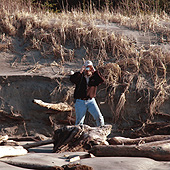 Area Data: Haida Gwaii, formerly known as The Queen Charlotte Islands, is located in north-western British Columbia, about 130 kilometres from the mainland. Commonly referred to as ‘Canada’s Galapagos,’ Haida Gwaii consists of two large main islands – Graham Island to the North, and Moresby Island to the South – as well as over 150 smaller surrounding islands. The total land area of Haida Gwaii is approximately 3,840 square miles;
Area Data: Haida Gwaii, formerly known as The Queen Charlotte Islands, is located in north-western British Columbia, about 130 kilometres from the mainland. Commonly referred to as ‘Canada’s Galapagos,’ Haida Gwaii consists of two large main islands – Graham Island to the North, and Moresby Island to the South – as well as over 150 smaller surrounding islands. The total land area of Haida Gwaii is approximately 3,840 square miles;
FAQ
Tour BC – Haida Gwaii
Can I build a house on my new property?
Please note, if you are leasing a property from NIHO, you may not alter the property in any way, during the lease period, without first receiving written consent from Niho Land & Cattle Company Ltd.
Before building on your property, please check the zoning on your property to make sure what you wish to build is allowed in your zoning. Make certain your property is not in the ALR or FLR, as these zonings strictly limit what may or may not be built on a property.
How can I subdivide a property?
Subdividing a property in British Columbia can be a complicated process.
First, what constitutes a subdivision? A subdivision is created when you do any of the following:
– combine two or more properties into one lot
– adjust an existing property line
– create several lots from one or more properties
– create several strata lots from one or more properties
– create several lots with the creation of a road on your property
In British Columbia,
How can I make an offer on a NIHO Property?
Our sales personnel will be happy to assist you in making your offer. Contact our office by phoning (604) 606-7900 or via e-mail to [email protected]. Please note that all property sales are on a first come, first served basis. We require a formal written offer to purchase the property, and our acceptance, before we will remove the property from the market for you. Should your first offer be rejected, our sales personnel will be able to provide you with assistance in creating a new offer which may be more acceptable.
What is a chain?
When the surveyors originally surveyed parcels of land in BC for the early homesteaders they used a compass and a chain. A chain is a measuring device that used to be made out of metal, now nylon, and is usually about 300 feet long
A chain is also a measurement. One chain equals 66 feet. The surveyor would measure his distances by stretching the chain along the ground measuring 4 chains at a time.
What is a forest cover map?
A forest cover map represents an 11.2 km x 14.6 km area, and can show you the species, averages ages and heights of the trees in the area. These maps are made from air photos by interpretation and already have all the typing and interpretation completed from the air photo. This map will interpret exactly what the air photo shows you but the codes on the map are explained and easy to read through a legend at the bottom of the map.
How were NIHO’s property boundaries set out?
The majority of NIHO’s property boundaries date back to the original surveyors of British Columbia.
In 1874, the Federal Free Homestead Act allowed settlers to buy their homesteads from the crown for about $1.00/acre, if they cleared, fenced, and resided on the land for 3 years. After the homesteader found a parcel of land he wished to homestead he would request a surveyor to come out and formally define his boundaries. The surveyors would then first establish the corner post and then the
Foreign ownership
Please note that the following is meant as a guideline only, and is not meant to represent legal advice. In purchasing any property, NIHO strongly advises seeking advice from a notary public or lawyer.
What taxation is payable when a non-resident purchases land?
There is a Property Transfer Tax, or a PTT, which both Canadian residents and non-residents have to pay. This is payable when the sale transaction is registered at a Land Title office.
How much rain does BC get?
The climate of British Columbia varies greatly, influenced by latitude, the province’s mountainous topography and distance from the Pacific Ocean. This diversity causes wide variations in average hours of sunshine, rainfall, snow and temperatures, sometimes over remarkably short distances.
For example, the average yearly precipitation in White Rock, a small community just south of Vancouver, is 1,092 millimetres (43 inches). Less than 50 kilometres (30 miles) away in North Vancouver, the North Shore mountains force clouds to rise and release their moisture,
Can I drink BC water?
You can get natural freshwater access on a property through several different sources. You can get water from lakes, rivers, and creeks on your property.
It is strongly suggested that you disinfect water from BC’s lakes, rivers, creek, and shallow wells.
Drinking water is disinfected to kill disease-causing micro-organisms (bacteria, viruses and parasites) which may be in it.
Many different diseases are spread by drinking water contaminated by micro-organisms,

